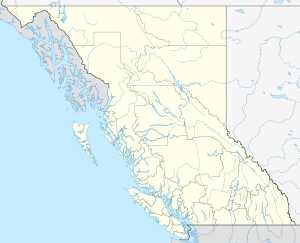Lions Gate Bridge
Coordinates: 49 ° 18 '53 " N , 123 ° 8' 21" W.
| Lions Gate Bridge | ||
|---|---|---|
| South end of the Lions Gate Bridge, looking towards the North Shore Mountains | ||
| Official name | First Narrows Bridge | |
| use | Road bridge (three lanes) | |
| Crossing of | Burrard Inlet | |
| place | Vancouver , North Vancouver | |
| construction | Suspension bridge | |
| overall length | 1517.3 m | |
| Longest span | 472.75 m | |
| height | 111 m | |
| Clear height | 61 m | |
| vehicles per day | 60,000-70,000 | |
| start of building | March 31, 1937 | |
| opening | November 14, 1938 | |
| planner | Monsarrat and Pratley | |
| location | ||
|
|
||
The Lions Gate Bridge (officially First Narrows Bridge ) is a suspension bridge in the Canadian province of British Columbia . It bridges a narrow section of the Burrard Inlet fjord and connects Vancouver with North Vancouver and West Vancouver . The name of the bridge refers to the twin peaks The Lions in the North Shore Mountains .
The total length of the bridge including the viaduct to the north is 1823 m, the actual length 1517.3 m, the mean span 472 m. Their field widths are 187.28 m - 472.75 m - 187.28 m.
The pylons are 111 m high. The suspension cables were made from bundled wire ropes instead of the usual parallel wire ropes . The roadway is at a height of 61 m. Depending on the volume of traffic, the use of the middle of the three lanes with traffic lights can be designed flexibly. 60,000 to 70,000 vehicles use the bridge every day, trucks over 13 tons are not permitted.
The Lions Gate Bridge is a landmark for the city of Vancouver and the communities on the north bank of Burrard Inlet. It had the longest span of all suspension bridges outside of the United States until it was replaced by the Pont de Tancarville in 1959 . Film director Robert Altman named the Lions Gate Films company he founded after the bridge.
On December 10, 2004, the bridge was officially recognized as a National Historic Site of Canada .
history
The idea of bridging the first bottleneck in Burrard Inlet first came up around 1890. However, there was also resistance to the construction of a bridge. It was feared that the Stanley Park landscape could be destroyed and the busy shipping traffic severely restricted. The first project was rejected in a referendum in 1927. The second vote on December 13, 1933, however, was successful in a ratio of 2: 1. The Irish brewery family Guinness had acquired a 16 km² area in West Vancouver and wanted to develop it, which is why they took over the construction costs. After lengthy negotiations with the federal government, the building permit was issued with the condition that as much material as possible from Vancouver be used and that local workers be used to alleviate unemployment during the global economic crisis .
The bridge was designed by the Monsarrat and Pratley engineering company from Montreal . Construction began on March 31, 1937. After a year and a half of construction, the bridge was opened to traffic on November 14, 1938. The construction costs amounted to 5,873,837.17 CAD , for the use of the bridge a toll of 25 cents per car had to be paid. On January 20, 1955, the Guinness family sold the bridge to the Province of British Columbia for CAD 5,959,060, and the toll was lifted in 1963. In 1975 the northern, slowly crumbling viaduct was replaced by a lighter, wider and stronger steel structure.
At the beginning of the 1990s, the provincial administration faced the choice of either completely renewing the aging bridge or tearing it down. Proposals included building a parallel bridge, drilling a tunnel from the city center to the north bank, or adding a second level of driving. Since the city of Vancouver did not want any additional traffic and the provincial government was unwilling to spend a lot of money, it was decided to renew the existing bridge and not build additional lanes. The renovation work took place in 2000 and 2001. The lanes were widened from 2.84 meters to 3.6 meters each, the sidewalks from 1.2 meters to 2.7 meters. As part of this renovation, the individual deck girder segments were replaced with wider ones. The two footpaths that were previously located between the two vertical guy lines have been moved to the outside. Only through this relocation was it possible to gain space between the two rows of trailers to widen the lanes.
In 2010 the bridge was used as the location for the opening sequence of Final Destination 5 .
Web links
- Lions Gate Bridge. In: Structurae
- Lions Gate Bridge ( English, French ) In: The Canadian Encyclopedia .
- Construction of the Lions Gate Bridge
Individual evidence
- ↑ Richard Scott: In the wake of Tacoma, suspension bridges and the quest for aerodynamic stability. ASCE Press, Reston, Va. 2001, ISBN 0-7844-0542-5 , p. 21
- ^ Lions Gate Bridge National Historic Site of Canada. In: Canadian Register of Historic Places. Retrieved March 15, 2013 .





